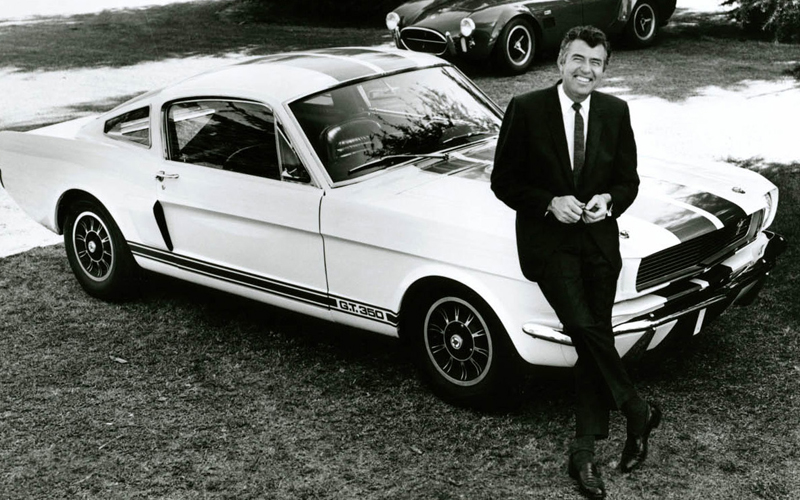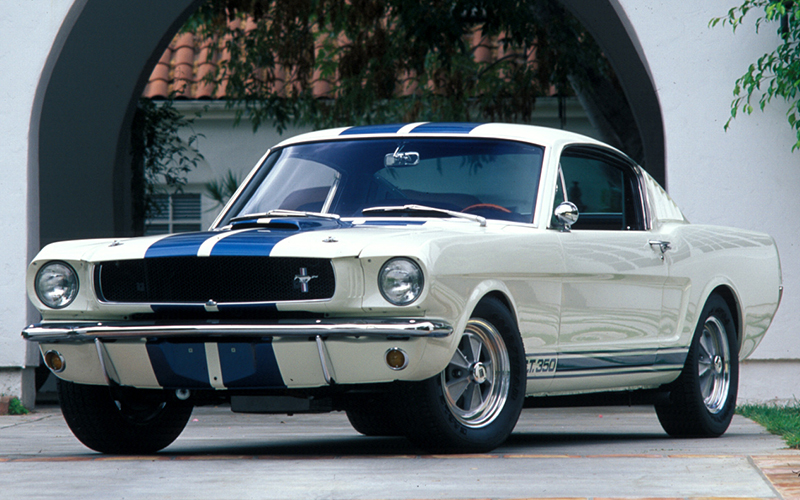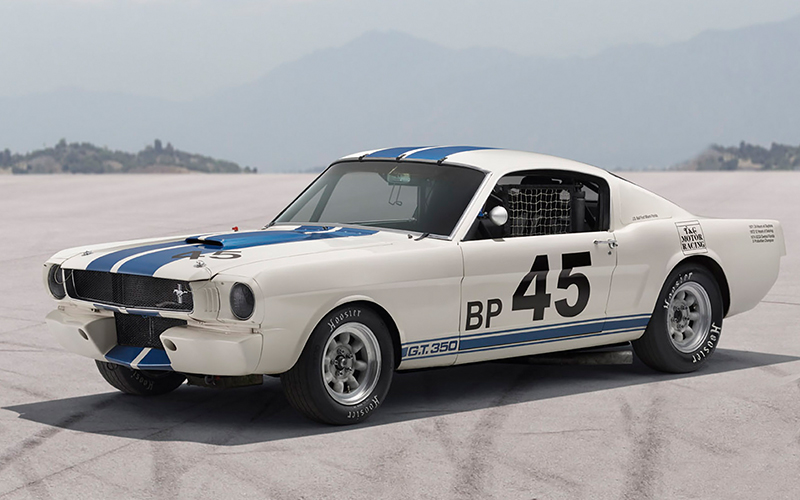55 Years of Shelby Mustang History
Over the 55 years of Shelby Mustang history, one powerful car after another hit the roads and tracks of America, culminating in the 2020 Shelby GT500.
The Man Himself
It all starts with Carroll Shelby. A talented driver (speed records at Bonneville, overall win at Le Mans) forced to retire from driving due to a heart condition; he looks for a path for the rest of his life. At Le Mans and sports cars races across the country, he raced against imported sports car repowered with American V8 engines. Along with his then business partner, they started to look for a suitable two-seat British sports car into which they could stuff an American V8 and go racing (and then sell a few more based on the results).

As luck would have it, Ford had just introduced it 289 CID small block V8, which Shelby installed into his selection of an AC Ace sports car. Word got back to the Ford Motor Company as to what he was up to, and Shelby was invited to world headquarters for an audience. What Shelby didn’t realize at first is that the Chevrolet Corvette was a stone in the shoe of Ford president Lee Iacocca, who was behind the company’s Total Performance initiative.

Carroll Shelby next to his Cobras – shelby.com | Shop Shelby Cobra on Carsforsale.com
With Ford’s blessing and support, Shelby began ordering AC Ace bodies from the UK, which were modified into Cobras at Shelby’s facility in Southern California. Its racing successes are well documented. In the spring of 1964, Iacocca launched the Mustang and, while incredibly successful from a sales perspective, wasn’t going to draw customers away from serious performance cars. Iacocca turned to Shelby to create a version of the Mustang that would not just create a halo for the model line but win races as well (which they did, beating small block powered Corvettes with regularity).
1964-1965

Carroll next to the Ford Mustang Shelby GT350 – shelby.com | Shop Ford Shelby GT350 on Carsforsale.com
Shelby American took delivery of its first Mustang just a few months after the car’s debut at the New York World’s Fair. The first task was to develop the street model of the Shelby Mustang GT350, of which 100 needed to be produced to qualify for racing.
Ford shipped to Shelby’s facility the first 110 partially-completed Mustang fastbacks for conversion. The cars were equipped with a solid-lifter 289 CID V8, a T10 four-speed transmission, and a Detroit Locker differential. All 110 were Wimbledon white on the outside, all black on the inside. Shelby would add the famous blue stripes at his shop.

Those cars were enhanced with high-performance intake and exhaust modifications along with brakes from a larger Ford model. Other modifications included a steering quickener, traction bars, modified front suspension, and some interior upgrades.
Work then commenced on the GT350R race version. These were stripped down as much as possible; there was no back seat or radio (which you couldn’t have heard anyway with the side exhaust pipes under the door).

The prime focus was on upgrading the engine, as so many chassis parts were the same as the GT350. The GT350R models rolled out with lightweight body panels and glass replaced by Plexi, while a roll bar dominated the interior and a 34-gallon fuel tank took up much of the trunk.
In its first race, Valentine’s Day 1965, the GT350R took top honors in the Sports Car Club of America (SCCA) B production class, ending the season as national champions. The legend of the Shelby Mustang had begun. What followed over the next 55 years is a series of Shelby Mustangs that epitomized what a domestic performance car should be.
1966
Several changes were introduced for the 1966 model year to broaden the appeal of the Shelby GT350 (the Mustang moniker now dropped). New exterior colors were added. A three-speed automatic transmission was optional, as was a fold-down rear seat.

For 1966, Hertz Car Rental purchased around 1,000 GT350-H (for Hertz) models, all painted black with gold stripes. Once rental duty was concluded, the cars were returned to Ford for resale. Word has it that more than one GT350-H found its way onto a racetrack during its rental period.
1967

To better differentiate the GT350 from the base Mustang, Shelby American developed more aggressive front and rear fascia to be fitted onto the new 1967 Mustang. While the 1967 GT350s continued to be modified for increased performance over the Mustang, changes were less severe than on earlier models. More creature comforts began to be added as well. A 1967 Shelby GT500 was given to The Doors lead singer Jim Morrison by his record company as a reward for the group’s chart-topping success. The car was subsequently wrecked.
1968

The big news for 1968 was the introduction of the GT500KR, a Shelby-modified Mustang powered by Ford’s massive 428 CID (7 L) V8 topped with two four-barrel carburetors. A 1967 GT350 was fitted with a 650 horsepower 427 V8 from the Ford GT40, which Shelby drove at a Goodyear tire introduction, reaching speeds up to 170 mph.

1968 Ford Shelby GT500KR – carsforsale.com | Shop Ford Shelby GT500 on Carsforsale.com
Less well known at the time was that the success of these models strained Shelby American’s resources. By October of 1967, Ford had taken over-engineering and purchasing and by the following spring shifted modification of the Mustangs to one of its contractors in Michigan.
Ford dealers and some owners panicked in 1968 after receiving GT500KR models with paperwork indicating they were powered by a smaller, less powerful 390 CID V8. It was all down to confusion caused by how codes were assigned at the factory.
1969-1970

By this time, the market for high-performance street cars was winding down, and car companies were turning their focus to meeting new safety and fuel economy standards. The GT350 and GT500 continued for two more years based on the new Mustang models of that period.

Although no new Shelby Mustangs were built in 1970, several leftover 1969 cars were legally assigned new VINs indicating a 1970 model year after Ford added black hood stripes and a Boss Mustang lower front valance.
Ford had a much greater hand in the design of the GT350 and GT500 models, and the relationship with Shelby terminated in the summer of 1969. The Shelby Mustang would go underground for the next 36 years.
2006
The launch of the new Mustang in 2004 triggered Shelby American to return to its Mustang roots. In conjunction with Ford, it developed an anniversary edition GT350-H to commemorate the original arrangement with Hertz.

The new H model offered improved handling and acceleration over the stock Mustang and featured the same striking black and gold exterior colors as the original. They were again available for rental through Hertz locations, though with much tighter restrictions than in the past. Along with many other Shelby special editions, these cars were modified at Shelby’s Las Vegas facility. As we advance, we’ll only be reviewing the more widely available Shelby models manufactured by Ford.
2007-2009

Ford entered into a new business agreement with Shelby in 2006 to launch a new series of Mustang-based performance models. The first, the 2007-2009 Shelby GT500, was powered by a 500-horsepower supercharged 5.4 L V8. The new GT500 featured upgraded suspension, brakes, and wider tires. The GT500 could hit 60 in just 4.5 seconds – pretty much supercar territory at the time. Over 25,000 were produced over the three model years.

For 2008 and 2009, a “King of the Road” version of the GT500 was available as a limited-edition model. These models started as Shelby GT500 Mustangs manufactured by Ford and then shipped to the Shelby for modification and then shipped to Ford dealers for sale. The upgraded supercharged V-8 produced 540 horsepower, 40 more than the standard GT500, and was also fitted with a short-throw shifter, unique wheels, tires, and suspension settings.
2010

2010 saw a redesigned Mustang hit the showrooms, and the GT500 received some unique body components, including the hood, nose, and grille. Lessons from the previous GT500KR engine made their way to the standard 2010 GT500, the engine now rated at 540 horsepower. Ford Special Vehicle Team (SVT) developed the suspension upgrades, including stiffer springs, which improved handling both on the road and at the track.
2011-2012

Replacing the previous years’ cast-iron V8, the 2011 Shelby GT500 now featured an all-new aluminum-block supercharged 5.4 L V8 with an output of 550 horsepower. Ford improved the handling characteristics of the GT500, with a lower ride height and the company’s more responsive, selectable electronic power steering and stability control system with a Sport mode. New for 2011 was the “SVT Performance Package,” which offered stiffer springs and damper rates, a 3.73:1 rear axle ratio, and suspension upgrades for sharper handling.
2013-2014

The 2013 Shelby GT500‘s 5.8 L DOHC aluminum-block V8 engine produced 662 horsepower, making it the highest output passenger car engine built for sale in North America up to that time. Upgrades included new supercharger and intercooler designs, new cross-drilled engine blocks and cylinder heads, updated camshaft profiles, more robust head gaskets, a new carbon fiber driveshaft, six-caliper front and four-piston rear brakes, as well as upgraded clutch, transmission, and axles.
Ford advertised 0-to-60 times and top speed as 3.5 seconds and 202 mph. Changes to the 2013-2014 versions included new front end sheet metal and standard HID headlamps and new LED taillights. The grille was left as open as much as possible to cool the massively powerful engine.
2015-2018

2017 Ford Shelby GT350 – ford.com | Shop Ford Shelby GT350 on Carsforsale.com
Ford reintroduced the GT350 after a long hiatus in 2015. Its 5.2 L Voodoo V8 engine developed 526 horsepower. The Voodoo engine featured a flat-plane crankshaft, lighter than a standard crank that allowed for higher engine RPMs. The downside was increased sound and vibrations, though not big issues for a track-focused car like the GT350.
In addition to its engine, other modifications included performance chassis tuning, wider front fenders housing special 295mm wide tires, significant aerodynamic changes, six-piston brakes with semi-floating rotors, lightweight six-speed manual transmission, and race-inspired seats.

For the true track rat, a GT350R was available to order. While mechanically similar to the GT350, it featured several aero upgrades, the ability to strip down the interior, and super lightweight carbon fiber wheels. The GT350 and GT350R were discontinued after the 2020 model year, replaced by a similar version, though less powerful Mustang model named the Mach 1.
2020

According to the Ford Motor Company, “the all-new Shelby GT500 (features) the quickest street-legal acceleration and most high-performance technology to date ever offered in a Ford Mustang.”

The 2020 Shelby GT500 is powered by a hand-built supercharged 5.2-liter aluminum alloy engine blown by a 2.65 L supercharger combined with an air-to-liquid intercooler. According to Ford, the 2020 GT500 engine develops 760 horsepower, which makes it the most powerful street-legal Ford ever and the most power-dense supercharged production V8 engine in the world. The transmission is a seven-speed dual-clutch automatic unit featuring several drive modes, including normal, slippery, sport, drag and track. For drag racing, there’s a line-lock and rpm-selectable launch control.

At the front, 16.5-inch two-piece brake rotors (reportedly the largest available from an American OEM) are fitted with stiff new six-piston calipers. Ford engineers tuned the aerodynamics of the 2020 Shelby GT500 in the company’s wind tunnel and in a rolling road tunnel favored by NASCAR teams. Two available handling packages with increasing levels of capability are offered for the Shelby GT500. The first adds adjustable MacPherson strut top mounts and a rear spoiler with a Gurney flap.
At the extreme, an available Carbon Fiber Track Package features 20-inch carbon fiber wheels, street/race tires, an adjustable carbon-fiber rear wing and front splitter wicker bills with an integrated dive plane.

1967 & 2020 Ford Shelby GT500s – ford.com | Shop Ford Shelby GT500 on Carsforsale.com









